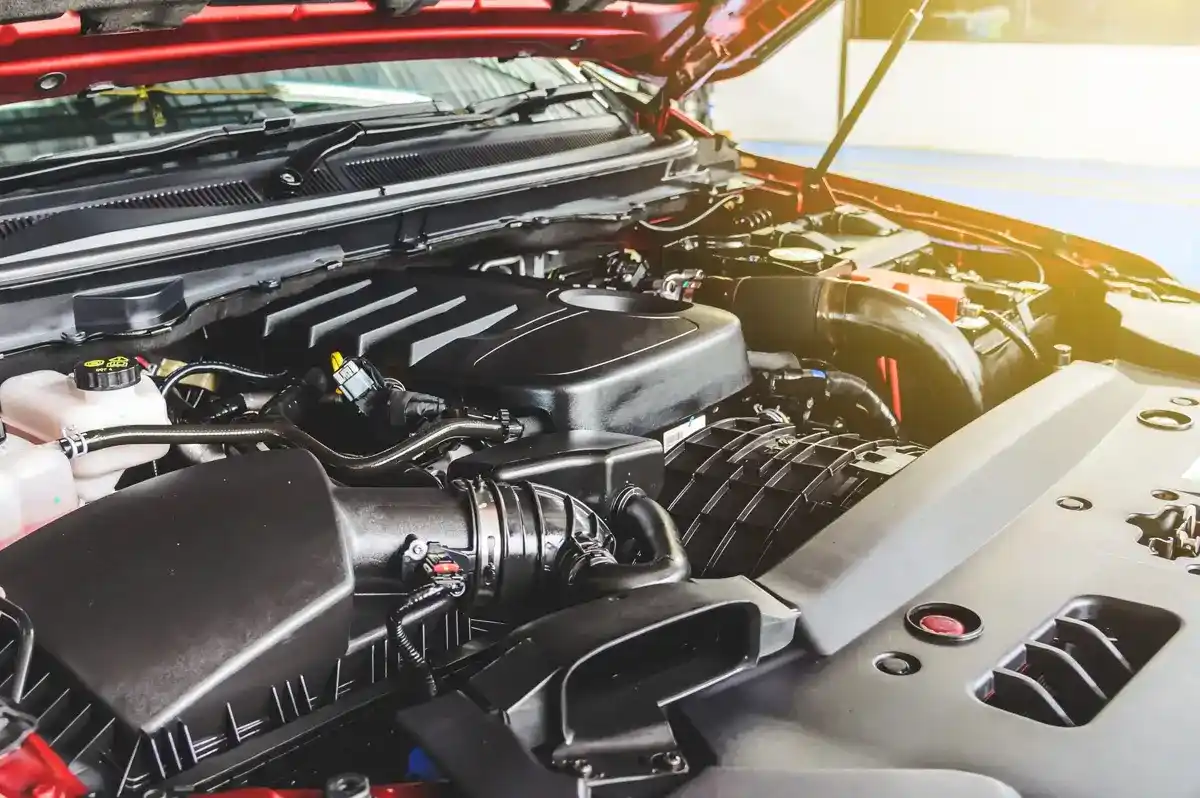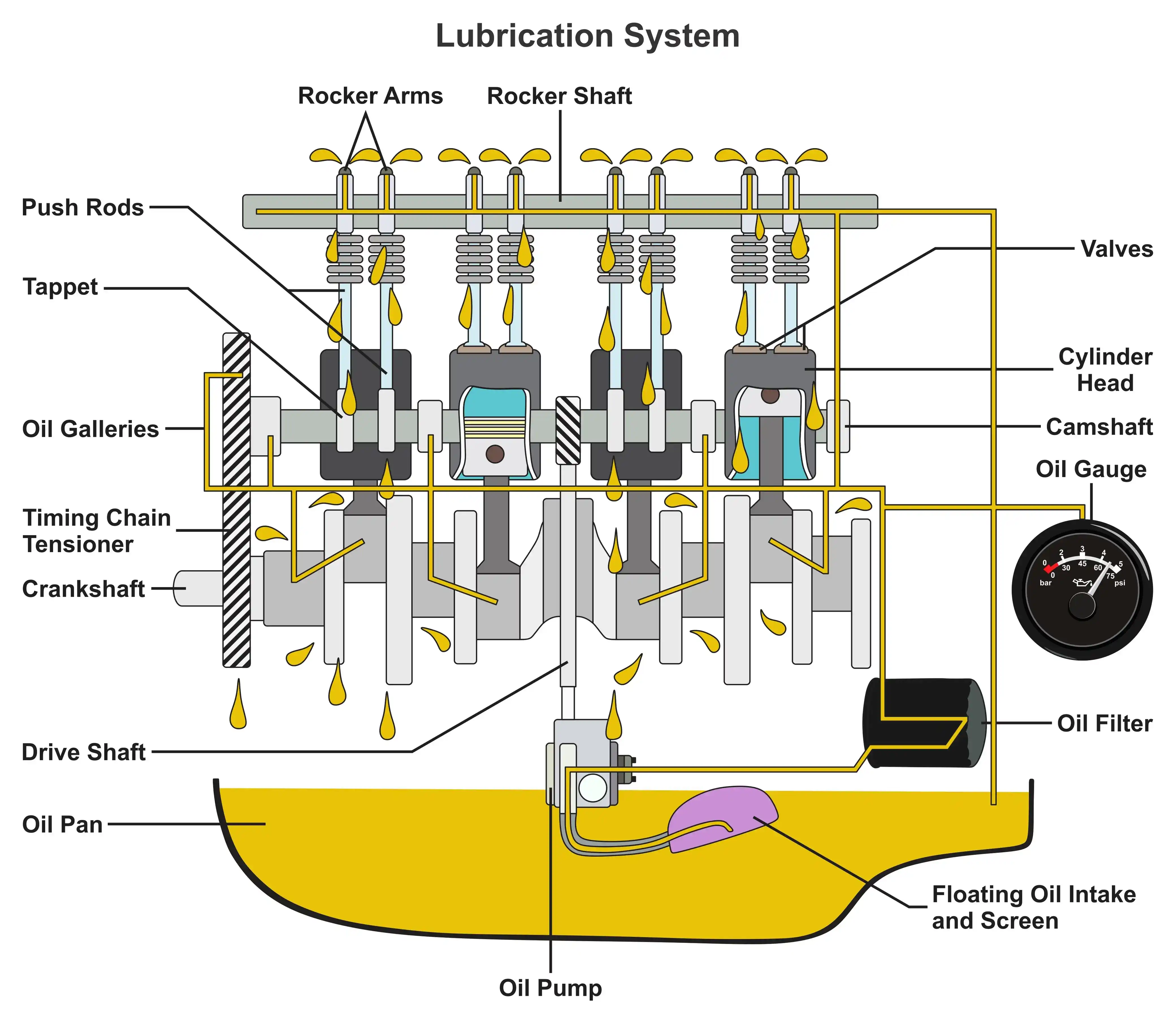How does the engine lubrication system work?
08 May 2024

You probably already know that your car needs engine oil to function properly. You may also know when to check your engine oil, how to top it up, and that it needs changing every once in a while. But how exactly does the engine lubrication system work? If you’ve ended up here, you’re probably wondering the same thing.
In this article, we’ll take a closer look at exactly how the engine lubrication system works in a typical vehicle as well as the various factors affecting the system.
What is a car engine lubrication system?
First things first, what exactly is an engine lubrication system?
Put simply, it’s the system that ensures oil is distributed to the various lubrication points within the engine. Lubrication points are the places where engine oil flows between moving parts, reducing friction and cooling vital components.
Both traditional internal combustion engines and electric motors rely on a lubrication system, although there are some key differences.
Most notably, an electric motor has far fewer moving parts than a petrol or diesel engine, and may even have a sealed lubrication system. This means lubricant is applied by the manufacturer and is expected to last for the lifetime of the car.
The following information refers to the components of an engine lubrication system in a traditional petrol or diesel car.
Key components in the lubrication system of an engine

Oil sump
Also known as the oil pan, an oil sump is a reservoir where lubricant is kept when the engine is not running. Located at the bottom of the engine, the oil sump also aids in dissipating heat. After oil has run through the engine and absorbed heat, it returns to the sump where heat can be released to the surrounding air.
An oil sump is typically made of steel or aluminium and can usually hold between 4 and 6 litres of oil, depending on the capacity of your vehicle.
Oil filter
The filter does what it says on the tin; filters out any dirt or contaminants that the oil may have collected while running through the system.
There are two main types, a full-flow or primary filter and a by-pass or secondary filter. The full-flow filter is designed to filter oil without interrupting the flow, ensuring sufficient lubrication even in colder temperatures. It can be of a spin-on or cartridge design.
The by-pass filter supports the full flow filter by catching any contaminant it may have missed, offering extra protection and prolonging the lifespan of your engine oil. A secondary filter either uses centrifugal force to trap contaminants or a magnet to trap metallic debris.
Oil pump
Once oil has been filtered out of the reservoir, it is circulated throughout the engine by the pump. Again, there are two types of mechanisms used here. A gear pump uses two meshed gears to create a flow of oil, while a rotor pump has a set of spinning rotors to generate oil flow. Both are powered by the engine.
Oil galleries
Oil galleries are the passages in an engine lubrication system that deliver oil to critical components such as the crankshaft bearings, camshafts, and pistons. These passageways are integrated throughout the engine block and cylinder head and are typically made of metal.
Key Lubrication Points
Bearings
Bearings are used to support various rotating parts including the crankshaft and camshaft. In the crankshaft, there are main bearings, and connecting rod bearings. As the crankshaft rotates, it splashes oil from the galleries onto the bearings, preventing metal-to-metal contact and reducing wear and friction.
Similarly, in the camshaft, there are journal and sometimes thrust bearings, to facilitate smooth rotation and axial movement control. Oil is pumped into the camshaft from the galleries to lubricate all of the bearings simultaneously.
Piston rings and cylinder walls
The piston (which moves up and down to allow your motor to run) has steel rings to close the gap between it and the walls of the cylinder. Oil is distributed here from the connecting rod holes to reduce friction between the two.
Valvetrain components
The valvetrain controls the intake and exhaust valves within an engine. Here, cam lobes press against lifters to transfer motion to the pushrods. The rockers then transfer motion from the pushrods to the valves to facilitate their opening and closing.
Oil may be forced up under pressure to lubricate the lifters, which then pump the remaining oil up past the pushrods to lubricate the rocker arm.
Alternatively, if your car has an overhead cam, oil will be carried to the cam through the galleries and then spilt onto lubrication points between the cam and valve stems.
Types of engine lubricants
The car engine lubrication system is a complex one that relies on multiple components to remain effective. One of the most critical components is the oil itself.
There are lots of different types of engine oil, and you must choose the right one for your car by consulting your vehicle’s handbook.
Some are mineral-based, while others have a synthetic oil base. Mineral-based oil is generally used in older engines and requires more frequent changes, while synthetic oil is becoming the more popular choice in modern vehicles thanks to its performance-enhancing capabilities.
Engine lubrication system maintenance
The best way to maintain your engine lubrication system is to stay on top of regular oil changes and filter replacements. This should usually be done annually or every 3000 to 6000 miles, whichever comes sooner. You should also check your oil every few weeks and top up as required.
A lack of oil prevents proper lubrication of all of the components mentioned above, causing metal-on-metal friction inside your engine. This has the potential to cause serious irreversible damage or even engine failure and overheating.
Common lubrication system problems
Many of the common problems with the engine lubrication system stem from low oil pressure, an engine oil leak, lubricant contamination, or a dirty oil filter. These can often be avoided with preventative maintenance as outlined above.
If you think there is a more serious issue with your engine lubrication system, such as an oil pump failure, you should always consult a professional mechanic for diagnosis and repair.
Maintaining a healthy engine lubrication system is an effective way to extend the lifespan of some of the most critical components inside your engine. A simple check of your engine oil every few weeks, along with changes at the recommended intervals is the best way to support your lubrication system in its essential operation.

